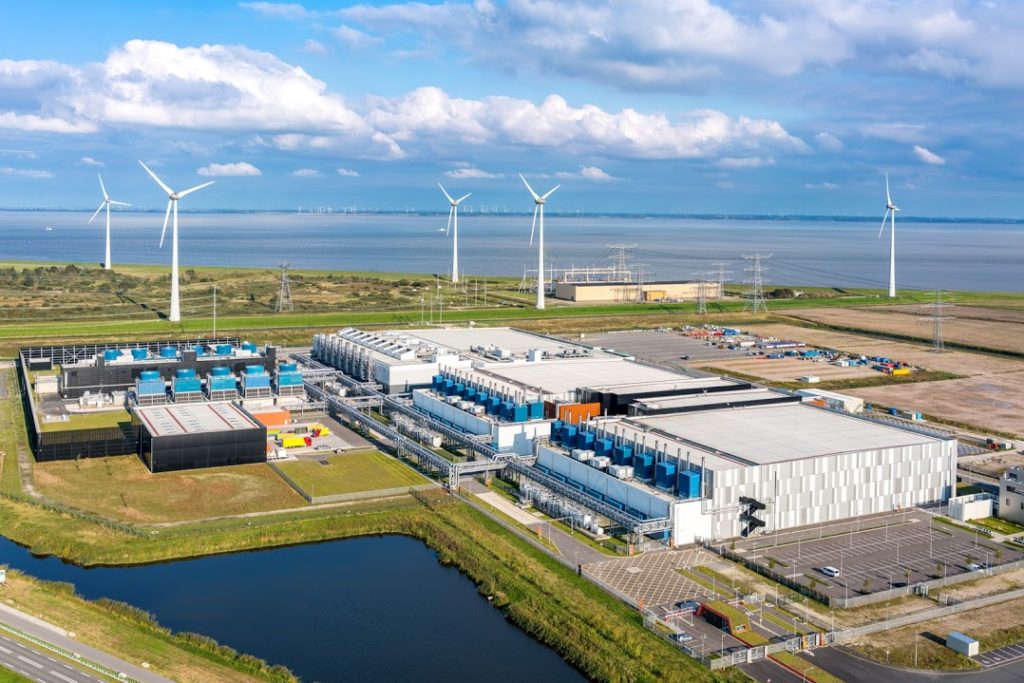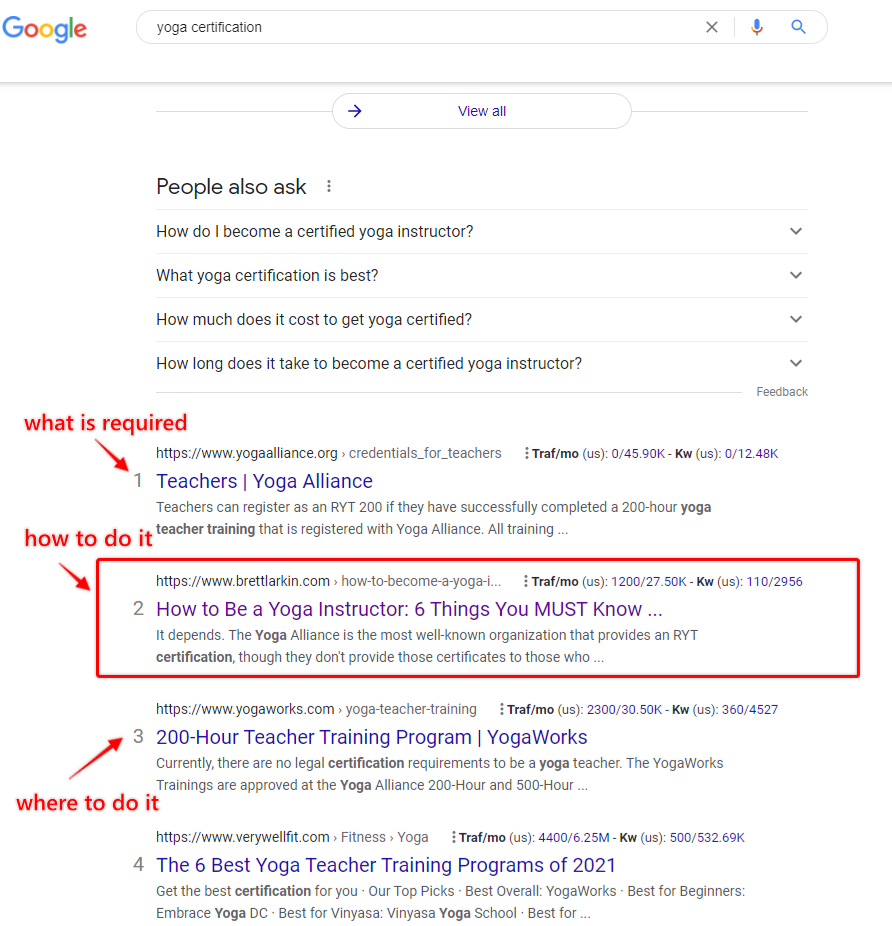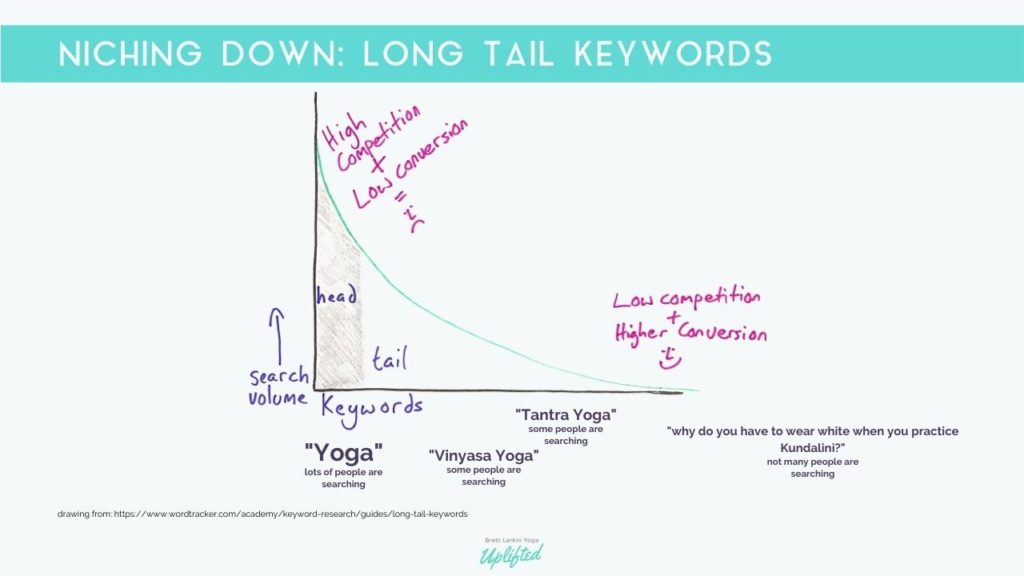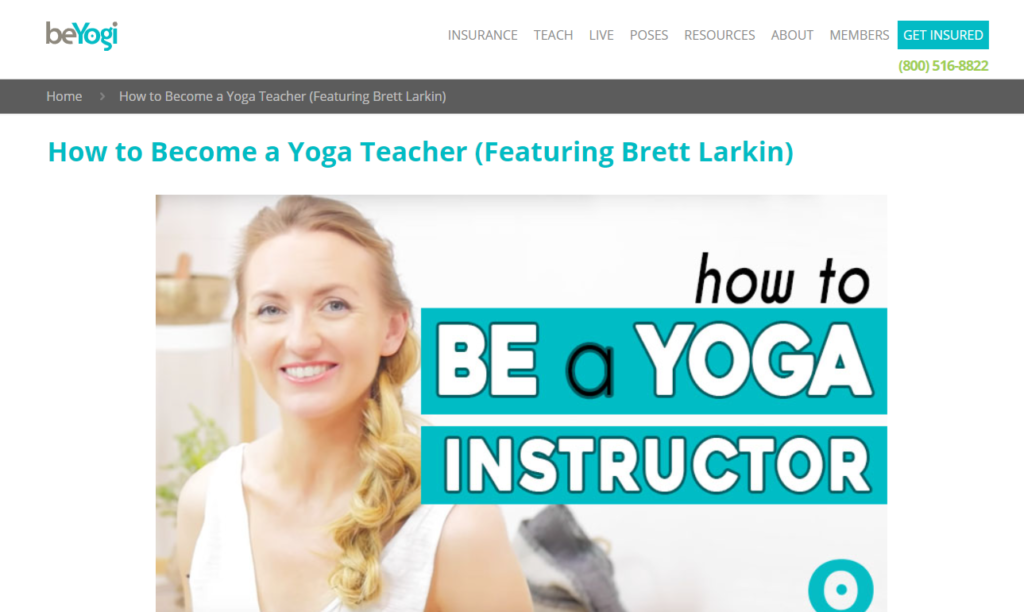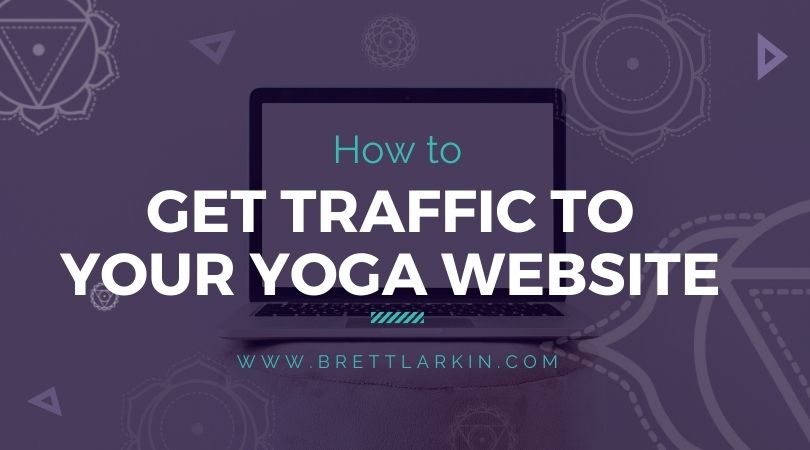
You know how washing machines and dishwashers are like some kind of modern household miracle that does the dirty work for you while you binge on your favorite Netflix series?
That’s kinda how SEO (search engine optimization) works.
You input what you want from the machine (the Google algorithm) and then let it do the dirty work (bring you customers) for you while you binge-watch Netflix, teach yoga classes, travel the world, or whatever else you might want to do with your time.
Besides the fact that you can save time with SEO, you can also save lots of money too.
After all, if your site is showing up in front of your target audience for free because of SEO, then why would you pay for ads anywhere else?
In fact, that’s exactly what we’re doing here at Brettlarkin.com. Brett hired me a few years ago to grow organic traffic (free traffic) to her site and that’s exactly what I did.
I’m an SEO; this is what I do and what I think about for ~12 hours a day, so I know my stuff. Or, at least, I know enough to bring in lots of website traffic.
And honestly, it’s not that hard to do. If you just follow the basic principles and have a tremendous amount of patience, it will work for you too.
Because I’m a search engine and keyword research nerd, Brett asked me to write this blog post to teach her students how to build the same kind of online empire as her. I’ll walk you through the same search engine optimization techniques that I used on her site to reach her target audience, increase brand awareness, and ditch paid advertising.
So uh, let’s get to it.
Search Engine Optimization 101
Before we begin, it’s best to understand more about Google and their algorithm. That way, you understand the “why” behind your content marketing strategy and are able to make solid decisions as you start to map out your plan.
The way the algorithm works comes down to three basic things:
- crawling
- indexing
- what the people want
So I’ll go over those here.
Crawling
As much as it seems like Google lives in a literal cloud and makes God-like decisions, it’s actually just a bunch of 1s and 0s living on servers all over the world.
In fact, every website lives on a server and about a year after Brett hired me, she had to upgrade her servers to accommodate more blog traffic…
…thanks to all of my on-page SEO efforts. *wink wink*
The server works like your own computer, holding all of the memory of which apps you use, what you recently opened, and how many random addresses and/or passwords you have. The computer “holds” all of this information in its memory to help make your experience better by having a faster operating system.
If you’ve ever noticed how your Chrome browser glitches the eff out when you have too many tabs or extensions open, then you’re seeing the limitations of memory space in tech.
And a memory of all of the internet lives on servers that Google owns, meaning that they need some epic memory storage to be able to handle it all.
You see, Google has little bots that we call “crawlers” because they crawl the entire internet. Just like spiders crawl freakishly fast across their nearly-invisible webs, the Google bots crawl the internet at lightning speed.
The crawlers follow URLs via links. So this is a link to a blog post I wrote about the basic ranking factors of SEO and Google will crawl that link when it crawls this blog post. So links are kinda like the threads of a spider web.
Indexing
Once the bots crawl a page, they take all the info they discovered back to their servers, where they live and store that information. When a user, aka your target audience, searches for something on Google, then the algorithm kicks in and searches through the servers for the most relevant information to the user search.
Once it finds the best fitting information, it shows it to the user.
NOTE: All search engines work this way (even duckduckgo). All search engines have similar algorithms. Google’s algorithm is just the best and they share some of their memory with companies to help them show paid advertising only to people who would actually want to see it.
So how does Google decide what to show someone?
This is where the algorithm comes into play.
The algorithm is insanely complicated and Google has never, ever publicly released anything about how the algorithm really works…
… so I won’t even begin to try to explain it here.
BUT, I can sum it up pretty concisely: Google just wants to be truly helpful to the user and connect them with exactly what they’re looking for.
What the people want
So Google remembers the entire internet and sifts through it whenever someone completes a search on Google, yeah? But how does it know which content is actually the best? Again: the algorithm.
A huge part of the algorithm depends on what content is on your page and how big your presence is on the internet.
The other half of the algorithm depends on what people do after they click “search”.
- do they click on the results that the algorithm chose?
- do they stay on the pages they click on?
- how much time do they spend on those pages?
- where exactly do they spend the most time on those pages and does that spot have some sort of significance?
- if they click “back” to the Google results page, what do they do next? do they click on something else? or do they refine their search?
- how many more searches do they do after that first one? and how are those topics related?
- do they click on the blue title that shows up or somewhere else?
And the list goes on forever.
So Google is watching BIG TIME our every move on the internet, not to be creepy but to truly understand what we want when we search for something.
For instance, this search term “yoga certification” has tons of different stuff showing up for it, which tells me that everyone who previously searched for “yoga certification” were typically looking for a few different things: what is required for yoga certification, how to get yoga certification, and where to get yoga certification.
So that’s exactly what Google decides to show.
So when you create content for your site, you basically just want to help Google find your content and know who exactly to show it to. If you can do that, then you’ll never have to worry about paid ads again.
So that’s what I’ll get into now.
Niche Down
Google prefers to connect people with experts over generic low quality blogs on any topic, so it looks for sites that focus on a specific niche. This wasn’t always the case, with many big name sites clogging up Google simply because they were the first in their industry to build a website (looking at you, Yoga Journal). But users didn’t like that because those big sites don’t always have great content.
So Google started looking for niche blogs to show instead.
Luckily for you, that’s exactly what you are.
So instead of being just a yoga teacher, pick a specific niche (or 2! or 3!) and focus on that exclusively.
Brett, for example, has these few niche areas: Chakras, Kundalini Yoga, Yoga Teacher Training, and Prenatal Yoga.
We only write content on those topics within the broader topic of “Yoga.”
In SEO terms, niching down is the equivalent to targeting “long tail keywords.” If you took Stats in high school or college, then you’ll remember how a bell curve works.
Basically, the average is the most common thing so the middle of the graph looks fat and overpopulated. In our case, this is where the topic of “Yoga” would live.
As you move away from the middle, you statistically become less and less likely to exist. So fewer and fewer people would search for terms as you move farther away from the base term “Yoga”. This is where “Vinyasa Yoga”, “Tantra Yoga”, or “Kundalini Yoga” would live. They’re still popular, but not quite as popular as good ole’ “Yoga”.
Even further away from the fat center are the super specific and rare things, which are “long tail keywords”. So this would be like, “what is white tantra?” and “why do you have to wear white when you practice Kundalini?” It falls under “Kundalini Yoga” and even “Yoga”, but is a pretty specific question so it’s doubtful that all that many people are searching for that every month.
And because there aren’t that many people searching for it, bigger sites with impressive marketing budgets won’t target it as aggressively…
… giving you space to write some quality content on the topic and snag a number one position for that keyword.
While it seems counterintuitive to put all of your digital marketing efforts into long tail keywords that a small percentage of the population is searching for, it might comfort you to know that these are the best converting website visitors. Meaning, they’re the most likely to pay for your services.
It’s more bang for your buck, as they say.
Create Good Content
Sometimes it’s really hard to make quality content. It takes a lot of time, research, and creativity to publish something that really impresses a reader.
But it doesn’t have to be that hard to do.
In Google’s eyes, great content is what actually helps the user. They don’t care about the flashy stuff (but people do, so that’s why it helps). If you can help the user better than anyone else on the internet, then you have the greatest content.
If you’re not sure what great content is, then just pay attention to your own experience using Google. Notice when you click out of a page because it didn’t help you at all or, conversely, when you stay on the page and fully read the article. What about these experiences made you leave/stay?
The yoga industry is the perfect place to create great content because the biggest sites online right now are really, uh, lacking in quality stuff. Instead of quality, they’ve got a bunch of nonsensical fairies writing their musings on the general topic of “Yoga”.
As an SEO, I believe that’s exactly why Brett’s site has been so successful. We legitimately are the best yoga site out there. We explain things in an easy-to-understand way, we stay true to tradition, and the content we publish is easy to skim.
A few tips to create content that ranks:
- use headers, bullet points, bolded words, useful links, and images wherever possible
- use old content from your social media channels; either embed videos from YouTube, make shareable Twitter cards, and embed Instagram pics
- pay attention to what people are really expecting to find when they type in a search term; as tempting as it is to write about whatever your heart fancies, it’s best to write about what your potential customers actually want to read #sorrynotsorry
- whenever you can, do some internal linking by linking to other blog posts on your website when they’re relevant
- use a simple SEO plugin that reminds you to create a title tag, meta description, and add internal linking
- and follow proper grammar rules to make it easier for people to read
Get Published On Other Yoga Sites
So the fact that Google literally has only so much space to store/index your content, they sort of rely on the rest of the internet to tell them which sites are worth remembering. They do this by counting backlinks, or links you get from any other site that points to yours.
Don’t stress too much about this. It’s a tedious and slow process, so if you just put your head down and stick to it at whatever manageable pace you can, you’ll be fine. Google prefers natural growth over forced growth, anyway.
The easiest way to get links on other sites while you’re growing is by guest blogging on other yoga-related sites. If you have any yoga teacher friends or students you graduated with, then ask them if they wanna do a guest blogging swap. It’s the easiest way to get started and will help the both of you out.
Then, from there, continue expanding your reach by writing for other sites too. I wrote a blog post about how to get backlinks that will give you a lot more details about how to do this.
Some sites that accept guest publishing are:
- MindValley Blog
- YogaDownload
- Lifehack
- YogiApproved
- PurposeFairy
- Yoga Digest
- Yoga Basics
- Sivana Spirit
- Yoga Trade
- Yoga International
- The Yoga Nomads
- BeYogi
Keep Your Website Light and Clean
I won’t bore you with the details here, but I’ll explain it in a way that will help you make the right decisions about your site.
Remember how the Google bots crawl the internet just like a web, with links being like the threads of a spider web? Well, I wasn’t being specific enough. The coding is like the thread and the links are what take the bots from one layer to the next.
So HTML, CSS, JavaScript etc are all types of coding that the Google bots crawl to gather data.
I know it seems like something you’ll never have to think about, but that’s exactly why you absolutely MUST think about it. It’s people like you (and me) who screw it all up.
So you know how Brett had to upgrade to bigger servers to handle all of the fresh blog traffic our SEO marketing strategy was bringing in? Well, we also had to seriously clean up the coding on the website too.
The more blog traffic we got, the more frequently the bots crawled the site. As we created more and more content, we slowed the site down more and more…
…until it was so hard to crawl that Google stopped ranking us altogether. They said, “take a nap, Brett, you’re messy.”
We became that messy because the entire site was built with Wordpress plugins and the Divi Builder by Elegant Themes. These visual page builders are SO fun for people like you and me. We have virtually no coding experience, yet we can create the website we want to. It’s magic!
The problem?
Those kinds of tools clutter up the coding. Each little element that you drag and drop adds another line of code that will either conflict with other commands in the code or duplicate commands, causing overall mayhem.
And the more pages you build with a builder tool, the messier it will get.
When it’s messy, the Google bots can’t efficiently crawl your content (and it will be insanely slow and miserable for your readers). Since Google lives in little boxes all over the world, there is literally only so much capacity to crawl and index all of the sites on the internet. And if your site is taking extra time for the bots to crawl, then they won’t visit your site as frequently because you’re using up valuable resources (aka “crawl budget” in SEO terms).
And if it continues like this for too long, then the bots will stop crawling your site altogether.
So how do you keep your site “light and clean”?
- if using Wordpress, stick with the Wordpress blocks and skip the page builders
- don’t use any plugins that aren’t absolutely essential for your site to function
- use an image compressor plugin (in this case, this is an essential plugin) to compress all images when you upload them
- remove or fix any broken links
My favorite SEO plugin for Wordpress is RankMath. You can monitor broken links, get your title tag and meta description reminders, and a whole bunch of other awesome stuff that is a bit more technical.
Quick Answers
How often should I publish content?
It’s up to you 🙂 The more quality content that you publish, the faster your site will grow. Publishing 1-2 quality articles per week would be a healthy pace that would get you results (probably) within 6 months.
How long until my site is “big”?
This depends on lots of factors, most of which fall under the concepts I outlined above. As a general rule, don’t expect to see any results for at least the first 3 months. And if you aren’t publishing consistently, then it’ll be even longer than that. Realistically, you should start to see spikes and growth around 6 months if you are publishing 1-2 quality pieces a week.
What about keywords?
Yeah, those are important. But they’re mostly important when you’re trying to understand how competitive a keyword is and what to prioritize. If you want to, you can find an SEO app and use its keyword research tool to peek around for some cool ideas. But if you want to keep this low stress, then I suggest focusing on concepts and terms within your niche. Remember that the “long tail keywords” work to your advantage here!
Final Thoughts
This was a pretty detailed blog post, so great job making it this far. But I promise you that these fundamentals are what helped grow Brett’s site to where it is today. Of course, I know a lot of super technical and complex stuff about SEO, so it helps me prioritize tasks.
But no task, no matter how big or small, ever comes before the principles I outlined above. That is the constant force that has grown the site to what it is today. So if you follow these principles, you’ll be doing SEO without really trying.
Next Steps:
- Explore my Yoga Teacher Resource knowledge hub for more tips about how to grow your yoga business.
- Download my sequences for a jumpstart on your upcoming yoga classes!
- For more detailed tips, processes, and worksheets to supercharge your yoga business, download my yoga business launchpad course!

About the Author | Marquis Matson
Hi! I’m Marquis. I’m an SEO yogi nomad and I grow websites for a living. I train other people how to do what I do. You can see more about that at Ahimsa Digital. I like being in the garden, drinking coffee, and talking about science-y things. Let’s chat!

Sneak Peak into My 300-Hour YTT - FREE Videos, Info Session, Bonuses!

YOU MIGHT ALSO LIKE
- What Is Mindset Coaching? A Complete Breakdown
- 5 Affordable Yoga Teacher Insurance Plans (Updated 2024)
- 7 Steps To Start A Life Coaching Business
- Types Of Life Coaches: How To Choose Your Life Coaching Niche
- 20 Awesome Ways To Make Money As A Yoga Instructor
- Life Coach Marketing: A Comprehensive Guide For Long-Term Growth
- How To Get Clients For Life Coaching
- Are Life Coaches Worth It? Take This Self-Assessment To Find Out.
- How Much Does A Life Coach Make? Around $5k+ A Month
- How Much Do Yoga Teachers Make? (And How To Earn More)
- How To Become A Life Coach (For Yoga Teachers)
- How To Use Social Media To Grow Your Yoga Business
- How To Find Your Yoga Niche (And Make $5K/mo)
- How To Make $5k Per Month As A Yoga Teacher
- How to Plan a Yoga Retreat That Earns 6 Figures
- The Best Yoga Business Coaches to Skyrocket Your Income
- Best Blog Platform for Yoga Teachers
- How To Become A Yoga Therapist After Your YTT
- Managing Cash Flow and Profit In Your Yoga Business
- The Top 5 Biggest Fears of New Yoga Teachers
- The Best Yoga Playlists For Yoga Teachers
- Why You Need A Yoga Intake Form (FREE download)
- How to Make a Logo for Your Yoga Business (No Design Skills Needed)
- This Cold Email Will Help You Land a Corporate Teaching Job
- This Cold Email Will Help You Land a Studio Teaching Job
- Our Expert Advice On How and Why To Teach Corporate Yoga
- How to Upgrade Your Yoga Alliance Certification Designation to 300 / 500 RYT
- How to Register Your YTT Certificate With Yoga Alliance (With Photos)
- How to Get Traffic to Your Yoga Website With SEO
- How to Update Your Yoga Alliance Teacher Profile Step-by-Step
- 6 Best Online Course Platforms For Yoga Teachers (Ranked)
- How To Make An Instagram Business Account As A Yoga Teacher
- 12 Actionable Tips For New Yoga Teachers Who Are Scared To Teach
- How To Prioritize Student Feedback On Zoom
- How To Teach Yoga On Zoom With Two Devices In 6 Easy Steps

